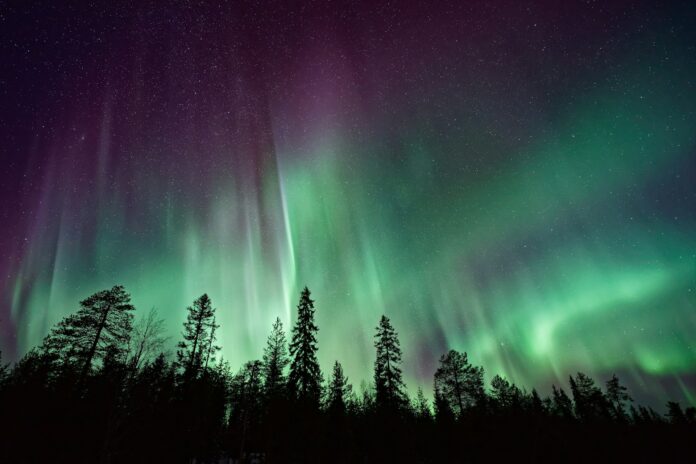Upcoming solar activity may create vibrant aurora displays over the UK, particularly in Scotland and northern England
The UK might soon be treated to another dazzling display of the Northern Lights due to intense solar activity. This potential spectacle follows a recent period where massive sunspot groups caused significant solar storms.
The mega sunspot group that bombarded Earth earlier this month has returned, already causing shortwave radio blackouts in Europe and the US. Experts predict that the best time for another spectacular aurora display will be around June 4 to 6, possibly extending to June 9, when the sunspots will be directly facing Earth.
The visibility of the Northern Lights will depend on the strength of the radiation hitting Earth, with Scotland and northern England having the best chance to witness the colourful night skies. Clear skies will be essential for viewing, and fortunately, the UK is expected to experience a heatwave in June following months of record rainfall.
Last month, sunspots named AR3664, which are 15 times wider than Earth, emitted powerful solar flares, leading to stunning aurora displays across the UK and Ireland on May 9. A week later, things intensified as AR3664 sent out the strongest solar flare of the current 11-year solar cycle, officially classed as an X8.7-class flare.
The Sun, always in motion, takes 27 Earth days to complete one rotation. Shortly after the major flare, the sunspot group turned away from Earth. Now renamed AR3697, the group has returned and remains highly active. On Monday, AR3697 fired a significant X-class flare just before turning to face Earth again, and astronomers anticipate more activity.
Solar flares are classified into five categories: A, B, C, M, and X, with X being the most powerful. Each class is graded on a scale from one to nine. This month’s X8.7 flare was nearly as strong as they get, while an A1.2 is considered minor. Monday’s flare, an X2.9, was powerful enough to cause shortwave radio blackouts in East Asia.
Solar flares are bursts of radiation across the electromagnetic spectrum, including X-rays and UV radiation. When these flares reach Earth, they charge particles in the atmosphere, which then interfere with shortwave radio signals by scrambling or absorbing them.
The potential for viewing the Northern Lights in the UK hinges on these solar flares. If the solar activity remains high, the charged particles will create vibrant auroras visible to those in the right locations. The UK, especially Scotland and northern England, could experience spectacular light displays.
The solar activity also comes with potential disruptions. The charged particles can affect radio communications, satellite operations, and power grids. However, the visual spectacle of the auroras often captures public attention and wonder.
The return of AR3697 and the anticipated solar flares offer an exciting opportunity for skywatchers. Those in northern parts of the UK should prepare for the chance to see the Northern Lights. Ensuring a location away from light pollution and checking weather forecasts for clear skies will increase the chances of a successful sighting.
As the Sun continues its activity, the next few days could bring more stunning aurora displays, making the night sky a canvas of vibrant colours. This celestial event underscores the dynamic nature of our solar system and the beauty it can produce.
Analysis:
The potential return of the Northern Lights to the UK offers a fascinating intersection of astronomy, meteorology, and public interest. From a scientific perspective, this event is a vivid demonstration of solar activity’s influence on Earth.
Politically, the Northern Lights have little direct impact. However, the phenomenon often garners attention from governmental agencies responsible for monitoring and mitigating the effects of solar storms. The UK government, particularly agencies like the Met Office, must remain vigilant to communicate any potential disruptions to satellite and communication systems due to solar flares.
Sociologically, the Northern Lights captivate public imagination and interest. Events like these often lead to increased public engagement with science and astronomy. Schools, museums, and observatories might see a spike in interest as people seek to learn more about the phenomenon. Additionally, the potential for clear skies during a heatwave could lead to communal gatherings and shared experiences of viewing the auroras, fostering a sense of community and shared wonder.
Economically, the potential visibility of the Northern Lights can have positive effects, particularly for the tourism industry. Regions in Scotland and northern England could see an influx of visitors hoping to witness the spectacle. This interest can boost local businesses, including hotels, restaurants, and tour operators. However, there are also potential economic disruptions if solar flares interfere with technology and communications.
From a local perspective, areas known for clear, dark skies will become focal points for those hoping to see the Northern Lights. Local authorities might need to manage increased traffic and visitors. Ensuring safety and accessibility for those viewing the auroras will be crucial.
Regarding gender and race, the Northern Lights do not have direct implications. However, the inclusivity of events and access to information about where and how to view the auroras should be considered. Efforts to provide equal access to all communities can help ensure that everyone has the opportunity to experience this natural wonder.
In summary, the anticipation of the Northern Lights over the UK due to returning solar activity highlights the interconnectedness of our natural world. The scientific marvel of solar flares and their impact on Earth presents an opportunity for public engagement and economic benefit, while also reminding us of the broader cosmic forces at play
